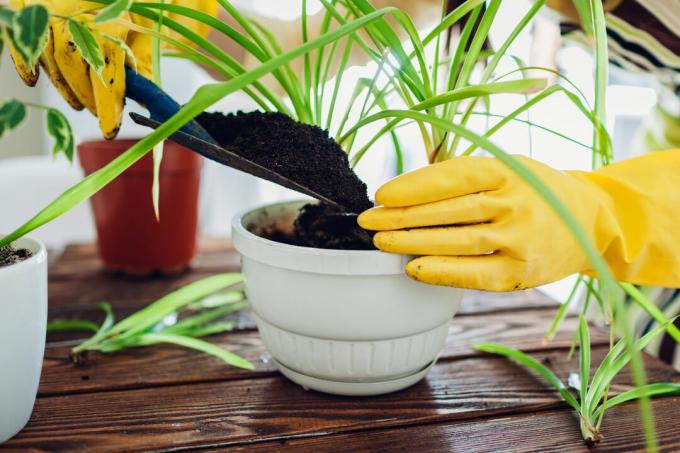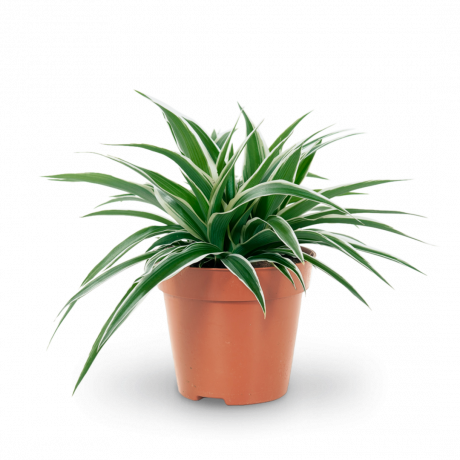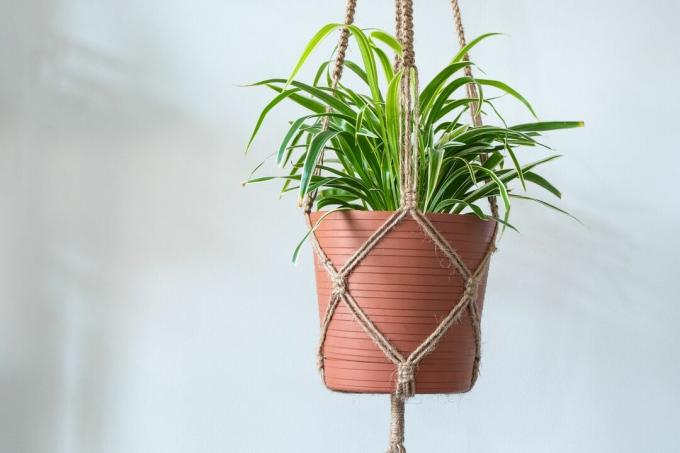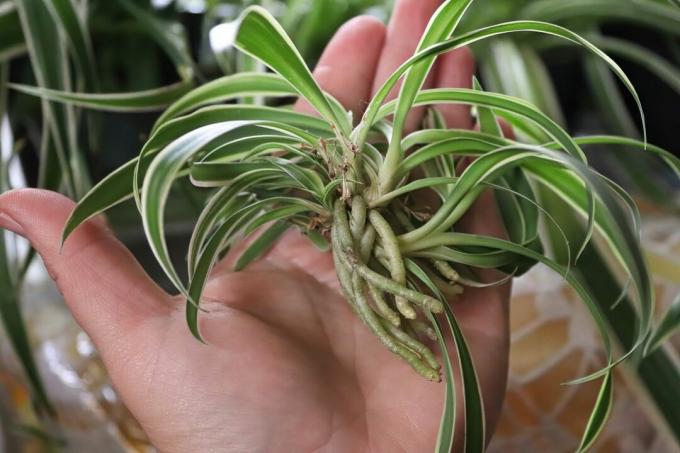Planting the spider plant is very easy - it requires very little care and is quite undemanding in terms of location.

There are several types of spider plant (chlorophytum spec.), but below we will deal with the most commonly used type Chlorophytum comosum. Little can go wrong when planting this spider plant. Nevertheless, in this article we explain in simple steps how it works optimally, so that the perfect basis for good growth is laid.
Contents
-
Plant spider plants: the right location
- Which soil is suitable for spider plants?
- Location as a houseplant
- Can spider plants be kept outside?
- Instructions: plant spider plants
- Repot spider plants
- Can you grow spider plants from seed?
Plant spider plants: the right location
In the following, we describe in detail which substrate is the right choice and in which location the spider plant thrives best.

spider plant
- Pet friendly hanging plant with white and green striped leaves
- Low-maintenance roommate – also perfect for beginners
- Feels at home in any room as long as it is light to partially shaded
Which soil is suitable for spider plants?
Also puts on the substrate Chlorophytum comosum no high demands. The optimal pH is between 6 and 7. A mix that contains coco coir and good quality compost works well. Accordingly, our peat-free Plantura organic universal soil a good choice: their pH is in the range of 5 to 7 and good quality compost is already included. In addition, the soil offers good water retention capacity with sufficient root aeration through plenty of coconut dust. This is a very good solution for the moderately thirsty spider plant, as the plant is somewhat prone to root rot. A soil with these properties is also the right choice for the other species.
Tip: The green lily grows preferentially Chlorophytum comosum in slightly clayey soils with good water storage capacity, therefore some clay meal or clayey garden soil can be added to the substrate.

Organic universal soil 40 L
- Ideal for all plants in the house, garden and on the balcony
- Ensures a vital & strong plant splendor as well as a healthy soil life
- Peat-free & climate-friendly: CO2-reduced organic soil made in Germany
Can you keep spider plants in water? Basically, it makes sense to keep the spider plant in hydroponics. However, if one decides to do so, this type of culture is best used from the start, as a switch is usually not well tolerated. Special fertilizers are required for hydroponics.
Location as a houseplant
The ideal location for the green lily is sunny to semi-shady, preferably without direct sun. It should be noted that variegated varieties tend to turn green if there is too little light. The humidity should ideally be 70% or more, because at lower values the tips of the leaves may turn brown. The leafy plant can be in warmer or cooler places, and it does well with both - a temperature of around 20 °C is ideal, when most of the children are formed. The mother plant in particular grows very well at 14 to 18 °C. However, spider plants stop growing at temperatures of 10 °C and below. The species have the same need for light and temperature requirements Chlorophytum orchidastrum and Chlorophytum viridescens on. If cats are kept as pets, an elevated location for Chlorophytum comosum be chosen that is not easily accessible for the animals. Because for some cats the leaves are attractive: they like to nibble on the leaves, which is not exactly beneficial for the plant in the long run. You don't have to worry about your cat because, as you can find out in our special article, she is Spider plant non-toxic. A pretty macrame hanging basket is very suitable for hanging the plants. This allows the long leaves and inflorescences to hang undisturbed.

Can spider plants be kept outside?
In summer, the spider plant can be cultivated outside in the semi-shade without any problems. When the temperatures drop again, it is placed inside, because spider plants are not frost hardy. There, however, it can also migrate to a slightly cooler place with about 10 to 15 °C for hibernation. A cooler winter location can encourage more robust growth, sometimes preventing potential pest infestations.
Instructions: plant spider plants
The spider plant is best divided in spring. So then is the best time to pot plants obtained in this way. Planting the green lily offshoots, i.e. the Kindel, is possible all year round.
At the beginning, a pot diameter of about 8 cm is sufficient for the children. The pot should have drainage holes for excess watering. Since the roots of the offshoots are not yet fully developed, it makes sense to only separate the children from the mother plant when they are well established. A first layer of the substrate is now filled into the bottom of the pot, then the plant is placed in the container in such a way that the leaf bases are flush with the top of the pot. Be careful not to break off the roots if they already exist. Now the rest of the pot is filled with soil, which is spread around the plant. The vessel can then be tapped lightly on a surface and the substrate pressed down a little so that the remaining cavities close. Then some more soil is refilled and finally the plant is watered.

Repot spider plants
Repotting the spider plant is only necessary when the storage roots are already clearly visible and the plant pushes itself out of the pot. If the spider plant is to be divided at the same time, it is best to repot in spring. In winter, the houseplant is better not repotted. The new planter should only be about two finger widths larger than the previous one. When repotting, the old soil is left between the roots. Only the cavities between the root ball and the new pot are filled with fresh substrate. The process is otherwise the same as described above.

spider plant
- Pet friendly hanging plant with white and green striped leaves
- Low-maintenance roommate – also perfect for beginners
- Feels at home in any room as long as it is light to partially shaded
Tip: One might tend to give the plants significantly more space in a larger pot - but the lower magnification is the right decision here. A potted spider plant consists of many individual spider plants, which creates a nicer, bushy look. To give you a better idea, it should be mentioned that up to 120 plants fit on one square meter.
Can you grow spider plants from seed?
Growing spider plants from seeds makes no sense, as most flowers do not fully develop and therefore do not form spider plant seeds. Besides, it works Green lily propagation via seeds only for the green-leaved wild form, which is usually not found in the trade.

After planting, proper care is important. In our further article you can find out everything about Spider Plant Care read.
Register now for the Garten-Post and receive great tips, seasonal trends and inspiration on everything to do with the garden from our expert every week.
